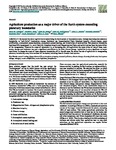Agriculture production as a major driver of the Earth system exceeding planetary boundaries
| dc.contributor.author | Hall-Spencer, Jason | |
| dc.date.accessioned | 2017-10-13T09:37:38Z | |
| dc.date.available | 2017-10-13T09:37:38Z | |
| dc.date.issued | 2017-10-12 | |
| dc.identifier.issn | 1708-3087 | |
| dc.identifier.issn | 1708-3087 | |
| dc.identifier.other | art8 | |
| dc.identifier.uri | http://hdl.handle.net/10026.1/10057 | |
| dc.description.abstract |
We explore the role of agriculture in destabilizing the Earth system at the planetary scale, through examining nine planetary boundaries, or “safe limits”: land-system change, freshwater use, biogeochemical flows, biosphere integrity, climate change, ocean acidification, stratospheric ozone depletion, atmospheric aerosol loading, and introduction of novel entities. Two planetary boundaries have been fully transgressed, i.e., are at high risk, biosphere integrity and biogeochemical flows, and agriculture has been the major driver of the transgression. Three are in a zone of uncertainty i.e., at increasing risk, with agriculture the major driver of two of those, landsystem change and freshwater use, and a significant contributor to the third, climate change. Agriculture is also a significant or major contributor to change for many of those planetary boundaries still in the safe zone. To reduce the role of agriculture in transgressing planetary boundaries, many interventions will be needed, including those in broader food systems. | |
| dc.language | en | |
| dc.language.iso | en | |
| dc.publisher | Resilience Alliance, Inc. | |
| dc.subject | aerosol loading | |
| dc.subject | biogeochemical flows | |
| dc.subject | biosphere integrity | |
| dc.subject | chemical pollution | |
| dc.subject | climate change | |
| dc.subject | diversity | |
| dc.subject | freshwater | |
| dc.subject | land-system change | |
| dc.subject | nitrogen | |
| dc.subject | ocean acidification | |
| dc.subject | ozone depletion | |
| dc.subject | phosphorous | |
| dc.title | Agriculture production as a major driver of the Earth system exceeding planetary boundaries | |
| dc.type | journal-article | |
| dc.type | Journal Article | |
| plymouth.author-url | https://www.webofscience.com/api/gateway?GWVersion=2&SrcApp=PARTNER_APP&SrcAuth=LinksAMR&KeyUT=WOS:000419351000013&DestLinkType=FullRecord&DestApp=ALL_WOS&UsrCustomerID=11bb513d99f797142bcfeffcc58ea008 | |
| plymouth.issue | 4 | |
| plymouth.volume | 22 | |
| plymouth.publication-status | Published online | |
| plymouth.journal | Ecology and Society | |
| dc.identifier.doi | 10.5751/ES-09595-220408 | |
| plymouth.organisational-group | /Plymouth | |
| plymouth.organisational-group | /Plymouth/Faculty of Science and Engineering | |
| plymouth.organisational-group | /Plymouth/Faculty of Science and Engineering/School of Biological and Marine Sciences | |
| plymouth.organisational-group | /Plymouth/PRIMaRE Publications | |
| plymouth.organisational-group | /Plymouth/REF 2021 Researchers by UoA | |
| plymouth.organisational-group | /Plymouth/REF 2021 Researchers by UoA/UoA07 Earth Systems and Environmental Sciences | |
| plymouth.organisational-group | /Plymouth/Research Groups | |
| plymouth.organisational-group | /Plymouth/Research Groups/Marine Institute | |
| plymouth.organisational-group | /Plymouth/Users by role | |
| plymouth.organisational-group | /Plymouth/Users by role/Academics | |
| dcterms.dateAccepted | 2017-10-12 | |
| dc.identifier.eissn | 1708-3087 | |
| dc.rights.embargoperiod | Not known | |
| rioxxterms.versionofrecord | 10.5751/ES-09595-220408 | |
| rioxxterms.licenseref.uri | http://www.rioxx.net/licenses/all-rights-reserved | |
| rioxxterms.licenseref.startdate | 2017-10-12 | |
| rioxxterms.type | Journal Article/Review |


